
Reference Publication: Callahan, M., Parker, D., Sherwin, J., Anello, M., "Evaluation of Energy Efficiency Improvements to Portable Classrooms in Florida," Florida Department of Education, Tallahassee, FL., November, 1999. Disclaimer: The views and opinions expressed in this article are solely those of the authors and are not intended to represent the views and opinions of the Florida Solar Energy Center. |
Evaluation
of Energy Efficiency Improvements
to Portable Classrooms in Florida
Michael
P. Callahan, Danny S. Parker, John R. Sherwin, Michael T. Anello
Florida
Solar Energy Center (FSEC)
FSEC-CR-1133-99
Executive Summary
Florida has over 25,000 portable classrooms in use around the state. Energy costs for these structures exceed $20 million a year - or about 11% of all energy-related expenditures for educational facilities. Research has also shown interior ventilation rates in these classrooms typically fall far below the recommended levels in ASHRAE Standard 62-1989.
To explore ways in which costs might be reduced and the physical learning environment improved, we conducted a two year experiment in two highly instrumented portable classrooms at Silver Sands Middle School in Volusia County. A series of retrofits, aimed to cut energy use and improve ventilation and illumination quality, were staged into the portables over time.
Within a year-long period of baseline monitoring, we verified that a typical Florida portable classroom used about 30 kWh/day. Measured energy end use was evenly split between lighting and space conditioning which accounted for more than 95% of total consumption (Figure E-1). We found that the baseline ventilation rate in the classrooms only to be about 2.6 cfm per student; daily carbon dioxide (CO2) concen-trations approached 2,500 ppm. Within the project, we demonstrated that several fundamental alterations in portable classroom equipment and roofing can produce very large reductions in total facility energy consumption. The specific improvements were:
-
T8 lighting system with electronic ballasts
- A high efficiency heat pump with enthalpy recovery ventilation
- A metal white reflective roof system
- An occupancy based control system for lighting and air conditioning
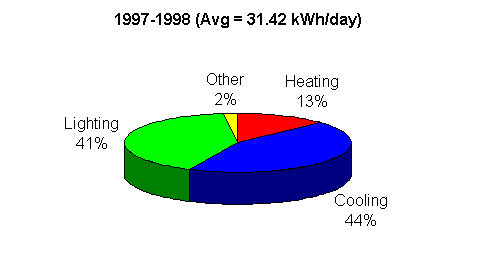
Figure E-1. Energy end-use in Portable 035 prior to the retrofit
(October 1997 - May 1998).
These energy improvements have the large side benefit of potentially improving classroom indoor air quality and illuminance levels. The lighting system and occupancy control reduced lighting energy use by an average of 53% (7 kWh/day) from one year to the next. Total annual savings were estimated at 2,500 kWh, worth about $200 at current electricity prices.
A package of measures - improved heat pump, an enthalpy recovery ventilator (ERV) and a reflective white roof - were incorporated to cut cooling energy use while providing higher levels of ventilation. The ERV was able to provide five times the ventilation air (13 cfm/student) found in the initial configuration, while still controlling indoor humidity to an acceptable level. This significantly cut internal CO2 levels with a potentially beneficial impact on indoor air quality (Figure E-2). Total reduction in space conditioning energy needs was 39% or about 6.9 kWh/day. Annually, the 2,520 kWh savings is worth about $200 in reduced operating costs.
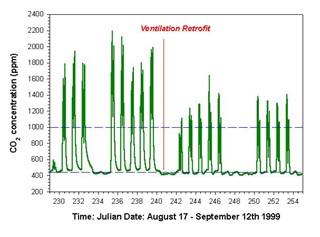
Figure E-2. Measured interior carbon dioxide concentration
in
Portable 096
before and after greater outdoor ventilation air
was provided by ERV.
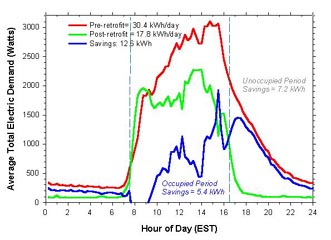
Figure E-3. Total average daily energy demand in the
year before (red) and
after (green) retrofit.
time of day energy
savings are shown in blue. Total savings are 41%.
Figure E-3 shows the total impact of all the retrofits on daily energy consumption in Portable 035 from the baseline year to 1998-1999 when all retrofits were in place. Measured annual energy reduction for the overall project averaged 12.6 kWh/day for a reduction of 41%. Although miscellaneous consumption increased slightly in the year post retrofit, the total annual energy savings have a value of about $370 a year in reduced operating expenses.
Our project conclusively demonstrates the feasibility of altering new portable classrooms in Florida so that they use 40% less electricity than standard practice. Energy savings greater than 30% were demonstrated for existing portable classrooms through automated controls and simple changes to the lighting system. If this alone were accomplished in all of Florida's existing portable classrooms, the reduction in annual energy related expenditures would exceed $6 million.
The
improvements were shown to be economic (rate of return on investment > 20%),
both for retrofit of existing portables classrooms as well as for
re-design of new facilities. Further, our results indicate important
side benefits: better ventilation and potential indoor air quality
as well as improved desktop illumination. Both improvements would
enhance the learning environment.
Introduction
Under contract with the Florida Department of Education (FDOE), the Florida Solar Energy Center (FSEC) has performed a study to determine how significantly energy consumption in portable classrooms can be cost-effectively reduced. The purpose of this study was to determine if portable classrooms in Florida can be made more energy efficient either by retrofit or at the time of new portable construction.
Secondary objectives were to see if the learning environment could be improved as part of the efficiency measures. This included thermal comfort, ventilation and illumination quality. The evaluation was accomplished through test of chosen measures in occupied classrooms. Since economics were important both energy savings and costs were tracked.
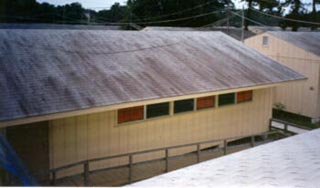
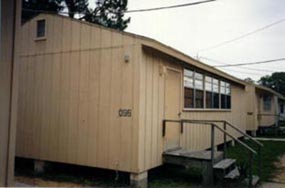
Figure
1. Photographs of the identical portable classrooms monitored
at Silver Sands
Middle
School
in Port Orange, Florida. Portable
035 is on the right and 096 is on the left.
Two adjacent classrooms were monitored for a year to collect baseline data, then energy efficiency measures were installed to analyze the effectiveness of each retrofit over time.
Retrofits included:
. Lighting: T12 lamp-magnetic ballast lighting system replaced by a more efficient T8 lamp-electronic ballast lighting system.
. Roofing: Gray asphalt shingle roof replaced with a reflective white metal roof to reduce cooling loads related to heat transfer from classroom ceilings.
. Heating, Ventilation and Cooling (HVAC): A three ton wall hung heat pump was replaced with 2½ ton higher efficiency model.
. Ventilation: Enthalpy recovery ventilation system added to provide greater outdoor air while controlling indoor humidity and energy impacts.
. Automated Controls: Occupancy based controls to turn off space conditioning when the classroom is unoccupied.
Background
Demands for increased classroom space against budget restrictions have resulted in a greater number of installed portable classrooms in the Florida school system. Where these relocatable classrooms were once thought to be temporary structures, it is now accepted that they are more or less permanent (Florida Today, 1997).(1)
Portable classrooms are often poorly received by the community (Stoddard, 1997). They are typically judged as substandard educational facilities and have been called "eyesores" and "monotonous and uninspiring" (Educational Facilities Lab, 1964). Such perceptions arise from the portables' bland coloration and their often shabby appearance (Rasmussen et. al., 1995).
Florida schools have an average of 9.9 portables with 836 ft2 of conditioned floor area each (Callahan et al. 1997). There are over 2,500 schools in the state so that means approximately 25,000 portable classrooms are in use. In addition, the same study shows that each portable classroom uses approximately 10,840 kWh per year. This is corroborated by measured energy use at a central Florida elementary school of 360 kWh/day for 12 portables (Sherwin and Parker 1996). Thus, both statistical estimates as well as monitoring shows an average use of about 30 kWh/day for portable classrooms.
Based on such data, portables account for 11% of the energy budget for Florida public schools. We estimate that portable energy use statewide was 250 million kWh costing $20 million annually (Callahan et. al., 1997). The annual energy costs for Florida schools in 1995 was $205 million, so portable classrooms contribute significantly to the cost of annual operation.
Simulation analysis in a study of potential portable classroom improvements suggests that energy savings may be reduced up to 23% with a payback of less than 3 years (Brown et. al., 1997). However, empirical verification of this potential and demonstration of measured savings in hot climates has been lacking.
To
remedy this gap in knowledge, the Florida Solar Energy Center,
in conjunction with the Florida Department of Education, chose
a school upon which to conduct a real-world test. Silver Sands
Middle School is located in Port Orange in the Volusia County
School District. The school has 39 portable classrooms.
Site Description
Two portable classrooms with identical dimensions and configuration, numbers 035 and 096, were chosen for the study. The portable classrooms were of wood frame construction with shingle roofs and dark beige wood siding. They are rectangular in shape: 36 x 20 ft in an east-west orientation with north and south facing windows. The conditioned floor area is 720 ft2. Three 4.1 ft x 6.5 ft single-glazed windows are located on both the north and south sides of the portables. The total window area is 156 ft2 or 22% of the gross floor area. Insulation levels and other characteristics are summarized in Table 1.
Table
1
Description of Portable Classrooms
| Overall | |
| Construction |
Wood
frame construction, medium-colored shingle roof, corrugated
metal exterior sideing. Mounted on metal frame approx. 18 inches above grade without skirting material (i.e. open crawl space). |
| Floor
area |
720 ft2 (20' x 36', long axis oriented north-to-south). |
| Glazing |
22% of gross floor area, single pane casement. |
| Insulation | |
| Roof |
0.09 BTU/h . ft2 . oF (R-11) [estimated] |
| Walls |
0.02 BTU/h . ft2 . oF (R-5) [estimated] |
| Floor |
None |
| Baseline HVAC System | |
| Cooling |
Packaged wall-mounted, direct expansion (DX) heat pump 3.0 ton nominal capacity |
| Air
Distribution |
Constant volume |
| Supply
Fan Control |
Continuous fan operation (fan ON) |
| Thermostat
Settings |
75oF cooling, 70oF heating |
| Schedule |
8:00 am - 5:00 pm, "off" night and weekends |
| Internal Gains (peak) | |
| Occupancy |
30 ft2/person (approx.) |
| Lighting |
2,150 watts (3.0 W/ft2), fluorescent bulbs with prismatic fixtures. |
| Receptacles |
<100 watts (periodic usage of overhead projector, computer, etc.) |
| Schedule |
8:25 am - 3:30 pm weekdays, with some teacher occupancy before and after regular class hours. |
Instrumentation
Each portable classroom was fully instrumented with thermocouples that measured interior space, roof, decking and attic temperatures. The portables were also wired to measure how long the doors were opened. CO2 sensors measure carbon dioxide concentrations, an indicator of relative occupancy. Due to the high density in portable classrooms, indoor pollutant concentrations are a concern. Generally CO2 concentrations should be less than 1000 ppm in occupied buildings.
Project instrumentation also monitored total kWh, air conditioning (AC) kWh, and lighting kWh. A weather station at the site measured wind speed, ambient temperature, relative humidity, and solar insolation over a 24 hour period. Data averages and sums were stored by that data logger every 15 minutes. All this instrumentation was poled by a Campbell CR10 data logger which downloaded over a dedicated telephone line each night.
Lighting
Lighting represents a large portion of the total annual energy consumption for Florida schools. Lighting fixtures also produce a great deal of heat during their normal operation which increases the interior classroom sensible cooling load by an estimated average of 23% annually (Floyd et al 1995). Portables predominantly use T12 lamp-magnetic ballast lighting systems in their classrooms because they are the most inexpensive. However, newer slim-line T8 lamp-electronic ballast systems perform best in both commercial and educational facilities (Sherwin and Parker, 1996; Parker et al., 1996). These lamps combined with electronic ballasts consume less energy than T12 lamps with magnetic ballasts (58 W versus 90 W respectively in two-tube fixtures). They can also provide better desktop illumination than T12s with enhanced color rendering (McIlvaine et al., 1994).
For the lighting retrofit, the 24 fixtures in the portables with the old magnetic ballasts were replaced with 12 electronic ballasts wired in tandem. The T12 fluorescent tubes were then replaced with slim-line T8 lamps. Desk-top illumination levels were monitored pre and post retrofit.
Roofing
The portable classrooms monitored had A-frame roofs with gray asphalt shingle over 3/4" plywood decking. This is a common type of roofing used in portable classrooms around the state. The south facing segment of the roof is 36.25 x 11.75 ft. and the north facing segment is 36.25 x 15.75 ft. The north-facing section provides an overhang for a handicap accessible entranceway on this side of the building.
Roof replacement was performed since previous studies have shown that roof solar absorptance significantly impact interior temperatures and space cooling energy use even with ceiling insulation in place (Givoni, 1976). Dark roofs with low reflectivities increase peak interior plenum temperatures by 20 - 25oF and thus increase the need for space cooling by 15% or more in Florida's hot climate. Infrared thermographs of the roof on Portable 035 clearly shows the influence (Figure 2) of solar heat gain on the roof structure.
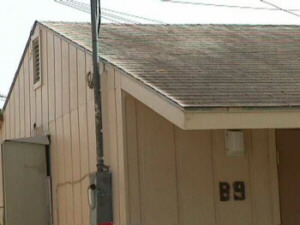
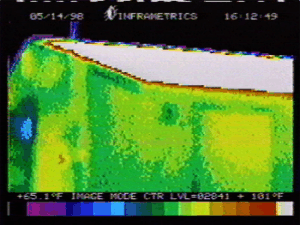
Figure 2. Conventional and infrared view of shingle roofing
system on May 14, 1998.
Color is proportional to temperature with
blues coolest and white the hottest.
Even light colored asphalt shingles absorb solar radiation readily. The reflectivity of light gray asphalt shingles is 22%, black asphalt shingles is 5%, but for a white metal roof is 67% (Anderson et al., 1991; Parker et al., 1993). In a series of twelve before/after experiments, Parker et al. (1995) demonstrated a space cooling electricity reduction of approximately 19% in residential buildings changed to a reflective roof system. This suggested beneficial impacts for this project.
Heating, Ventilation and Air Conditioning (HVAC)
Inefficient lighting and roof solar absorptance increase sensible cooling loads. Generally, space cooling use makes up one-third of a school's energy budget. A poorly sized or poorly maintained cooling and heating system can lead to major problems with indoor air quality, bacterial contaminants, viruses, mold, spores, and pollen (Brown 1995).
In a recent survey (Callahan et al. 1997), 252 schools of 655 schools with utility data had an average of 7.9 cfm per student, but with a highly bi-modal distribution with many schools having a ventilation rate of 5 cfm/student while others have a ventilation rate of 15 cfm/student. The schools HVAC systems with a ventilation rate of 5 cfm/student are likely older, especially in older portables that were not brought up to the new ASHRAE 62-1989 standard. This new standard may contribute to indoor air quality (IAQ) problems since a higher outdoor air ventilation rate will often produce greater moisture problems since control is difficult in such densely occupied spaces.
Evidence
suggests ventilation provided in portable classrooms is considerably
worse. Cooling systems in portable classrooms are predominantly
wall-hung through-the-wall cooling systems, often providing no
outside air due to closed or inoperable dampers.
Baseline
Energy Use and Related Characteristics
Baseline energy data was collected from both portables from September of 1997 until May 20th of 1998. This essentially gave an entire school year of data on the relative performance of the portables. A basic summary of the energy use data is shown in Figures 3 and 4.
Figure 3 shows that the measured total energy use in Portable 035 averaged 31.4 kWh per day - very similar to the average measured in previously cited studies. The majority of energy consumption in the portables was for space cooling and lighting. Some 17.6 kWh per day or 56% was used for space conditioning. Of this, 14.0 kWh/day (44%) was consumed by space cooling and 3.6 kWh (13%) was used for heating. Mean lighting energy use was 13.1 kWh/day or 41% of total consumption. Plug loads for projectors, computers and an outdoor night light averaged 0.7 kWh/day or just 2% of total use.

Figure 3. Energy end-use in Portable 035 in baseline data
collection period (October 1997 - May 1998).
Figure 4 shows a similar presentation of energy end-use analysis for Portable 096. Total energy use, averaging 19.1 kWh/day, was considerably less than Portable 35. Space conditioning energy use was much lower at 8.7 kWh/day (45% of total), partly due to higher temperatures maintained inside and a poorly functioning cooling system. The cooling system was the subject of a number of complaints from the instructor. Space cooling consumption was 6.7 kWh/day (35%) and heating was 10%. Lighting energy use at 9.5 kWh/day (50% of total) was also lower due to the teacher's frequent habit of turning off the perimeter lighting when using an overhead projector. Plug loads averaged 0.9 kWh/day or 5% of consumption.
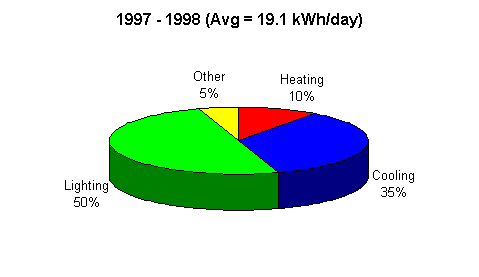
Figure 4. Energy end-use in Portable 096 in the baseline period.
Cooling
Figures 5 shows the average air conditioning electric demand profile at the two portables on weekdays during the school year. The higher demand at Portable 035 is clearly visible as is evidence of operation during non-occupied hours. These data suggests that automated controls may provide beneficial energy savings when used in portable classrooms.
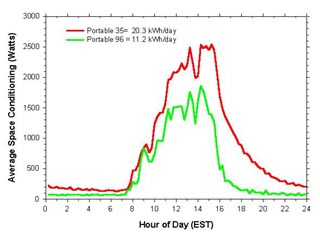
Figure 5. Average heating and cooling electric demand profile
in
the two portables classrooms over the nine month baseline period.
Interior Humidity Levels
Figure 6 shows the average interior tempera-tures and relative humidity maintained in the two portables over the school year. These indexes are important as widely varying indoor temperatures can be a source for student and instructor complaints and high humidity levels are correlated with perceived indoor air quality problems (Arundel et. al., 1996; Callahan et. al., 1997). Note that the highest relative humidity levels are reached soon after full classroom occupancy at 9 AM when cooling system runtimes and associated machine moisture removal rates are low. In general, Portable 035 maintains significantly lower temperatures and relative humidities than its counterpart. Based on dissatisfaction from the instructor in Portable 096, part of this difference may be to poor function of the cooling system.
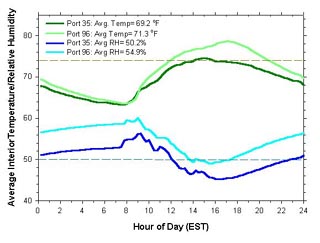
Figure 6. Average weekday temperatures and relative humidity
in
the two portables over the nine month baseline period.
Ventilation Effectiveness
Figure 7 shows the typical weekday CO2 concentration rate in the two classrooms. Carbon dioxide concentrations are a key parameter describing relative classroom ventilation rates. Research indicates that a 15 cfm/student ventilation rate is necessary to hold CO2 rates below a recommended maxi-mum of 1,000 parts per million (ppm) (Downing and Bayer, 1993). Note that CO2 concentrations in both portables readily exceed the 1000 ppm level by 11 AM and are sustained at over 1500 ppm from noon until 3 PM. We also observed that the CO2 levels at Portable 035 dropped off more quickly than Portable 096 post occupancy.
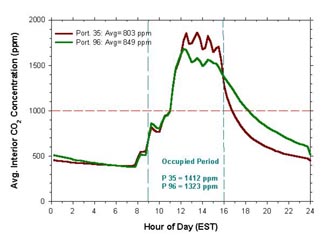
Figure 7. Average weekday carbon dioxide concentration levels
in
the two portables over the nine month baseline period.
Possible reasons for the lower post occupancy CO2 decay rate in Portable 096 are shown in Figure 8. This plot depicts the number of seconds in each 15-minute recorded interval in which the classroom door was open. For instance, an average rate of 200 seconds would indicate that the door was open 22% of the time (200/900 seconds). Note that the door of Portable 035 is open much more frequently during late afternoon hours. This reflects the habit of the instructor of opening the door to the portable during the late afternoon hours of moderate days when students often come and go for tutoring.
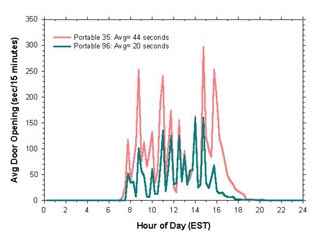
Figure 8. Average weekday door opening in the two portables
over the nine month baseline period. The
data shows the average number
of seconds the door was open in each 15-minute data collection interval.
Lighting Energy Use
Figure 9 compares the baseline lighting energy demand profiles for occupied days. Note that although average peak demand is similar (1200 Watts or approximately 1.7 W/ft2), the consumption in Portable 096 is lower, particularly after regular school hours. This indicates a behavioral difference between the portables in the tendency for consistent shutdown of overhead lighting during unoccupied evening hours.
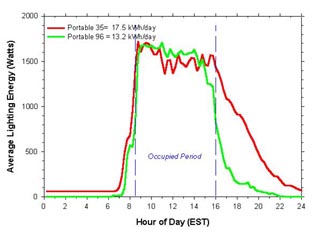
Figure 9. Average weekday lighting levels (Watts) in the
two portables over the nine month baseline period.
Evaluation of Retrofits
Lighting Retrofit
The lighting system originally in place in the portables was a T12 lamp-magnetic ballast lighting system with 24 two-tube F40CW fixtures (~90 W each). The connected lighting load is approximately 2.16 kW. The T8 lamp-electronic ballast lighting system was installed in Portable 035 on May 21, 1998 and in Portable 096 on November 23, 1998. The new two-tube T8 fixtures draw about 58 Watts with ballasts (Figure 10).
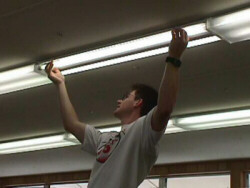
Figure 10. Lighting system retrofit for the portable classrooms.
As shown in Figure 11, the energy savings from the retrofit of the lighting system in Portable 035 was approximately 35% or 4.6 kWh on two matched days. The energy savings due to the retrofit for Portable 096 was very similar (Max load = 2,152 W for old system versus 1,276 W for new system).
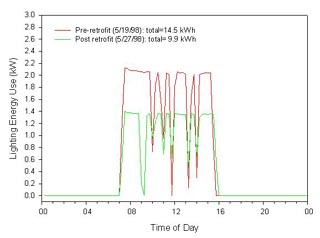
Figure 11. Graph of lighting energy use over the course of
two matched days for Portable 035.
Pre-retrofit total use was 14.5
kWh while post retrofit total was 9.9 kWh. Lighting power reduction
was 35%.
Figure 12 is a comparison of energy use for the portables on March 10, 1999, which was during the post retrofit period for both portables. Portable 096 used 58.9% (6.4 kWh) less over the course of the day than Portable 035.
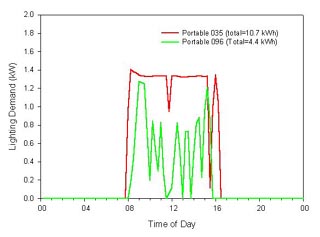
Figure 12. Comparison of differing lighting use for both portable
classrooms on
March 10, 1999 after the retrofit. Portable 035 uses
10.7 kWh while Portable 096 uses 4.4 kWh.
Generally, the instructor in Portable 096 operates fewer banks of lights during the day based on personal preference and extensive use of an overhead projector.
Lighting contributes significantly to the heat gain inside portable classrooms which affects cooling and heating energy consumption. Infrared thermographs were taken of the lighting system in Portable 035 prior to and following lighting retrofit (Figures 13 and 14 top of the next page). In the thermograph, color is proportional to temperature with the darker colors being cooler and the lighter colors hotter. Figure 13 demonstrates the heat produced by the old lighting system. The temperature range for both of the figures is 75.5 to 93.2oF and it is seen that the T12 fixtures heat up to over 93oF. In Figure 14 the infrared thermograph of the T8 lamps show that they run cooler than the T12 lamps. The violet color is proportional to 75-77oF for the efficient lighting system. Note also the cooler ceiling temperature brought about by the reflective roofing system.
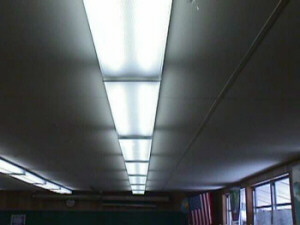
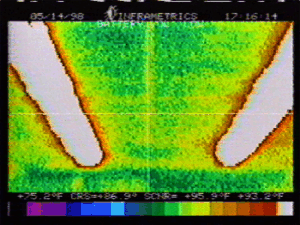
Figure 13. Infrared thermograph of the heat gain from the
pre-retrofit lighting system and ceiling in portable
in Portable
035 on the afternoon of May 14, 1998. The temperature range is 75.2oF
to 93.2oF. With the hot
attic space, the afternoon surface
temperature of the ceiling tiles is 86-87oF.

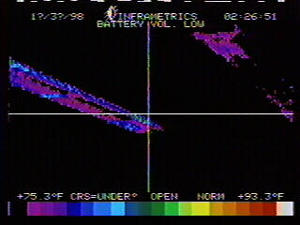
Figure 14. Infrared thermograph of the heat gain from the
post retrofit lighting system and ceiling in
Portable 035 on the
afternoon of June 30, 1998. The temperature range is the same as
before.
Note also the lower ceiling surface temperatures after the
reflective roof was installed.
Not only did the T8 lighting system cut energy use by 35 - 40%, it also provided better illumination. Light level readings were taken before and after lighting retrofit. Minimum classroom desk-top illumination levels are 50 foot candles and Illuminating Engineering Society (IES) recommended lighting levels are approximately 70 foot candles for fine reading tasks (IES, 1988) (10.76 decalux = 1 foot candle). Pre-retrofit average desk-top illumination for the lighting in Portable 035 was 89.9 decalux while post retrofit average brightness was 93.3 decalux for a 4% increase in the average light level. The T8 system also provides excellent color rendering resulting in a better quality of illumination. Illumination can have physiological affects on student's ability to learn, (McKinley, 1991). Classrooms with superior illumination and particularly those with better daylight may provide a better educational environment (Hathaway et. al., 1992).
Windows
Another significant impact on both lighting and space conditioning energy use are windows and daylighting. Windows are a major source of solar heat gain in Florida. The optimal orientation of windows is north-south facing, which is observed with the two studied portables. However, it would also be ideal to have the larger overhang on the south half of the building. Furthermore, the portables obviously have issues with solar heat gain and glare because the windows were covered with blinds and construction paper to combat these problems. Figure 15 shows the north windows of Portable 035. Note the construction paper attached to reduce glare, as well as the influence of insect screens on the bottom of the windows to provide better insolation of the windows. The white hot streak at the top is where the overhang meets the wall/roof sill plate.
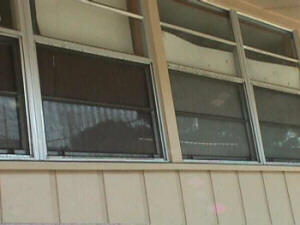
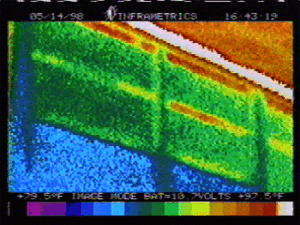
Figure 15. Exterior north facing windows on Portable 035.
The lower temperatures
on
the window surfaces indicate large levels
of heat gain to the interior.
To control glare and localized overheating in the classroom the teachers placed construction paper in the windows or have hung canvas from the ceilings to shade the windows. As demonstrated below by the infrared photos of the windows taken from inside, this crude strategy is somewhat effective (Figure 16). The temperature range is 62.5oF (darkest colors) to 98.5oF (lightest colors). Thus, changes the classroom windows to solar control glazing might be an appropriate energy and comfort related improvement to examine in future research.
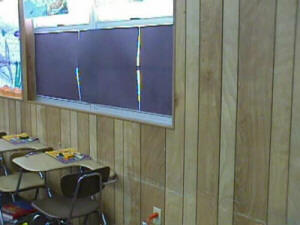
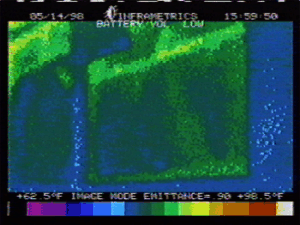
Figure 16. Interior view of the north facing windows in Portable
035 construction paper was
used to reduce afternoon glare and overheating
from direct sun. Note the lower temperatures
on the bottom half of
the windows due to the reduction in solar heat gain by the obstructions.
Heating, Ventilation and Air Conditioning
Significant improvements in energy use and ventilation were obtained by replacing the space cooling and heating system. The original Crispaire AVP36HPA 3 ton wall-mount unit was changed out to a Bard WH301-A 2½ ton unit based on the reduced sensible cooling load from lighting and the roof/ceiling. Details on the system are provided in Appendix A. The schematic and function of the wall-mount Energy Recovery Ventilator (WERV-2A2) is described in Appendix B. The system was replaced in Portable 035 on June 17, 1998 and in Portable 096 on August 31, 1999 (see Figure 17). The actual field performance of air conditioning system at Portable 035 was audited before and after change out of the unit. This was accomplished by measuring the power use and latent and sensible cooling of the equipment pre and post retrofit. A return air temperature of 76oF was maintained in both tests. The results and procedure are contained in Appendix D.
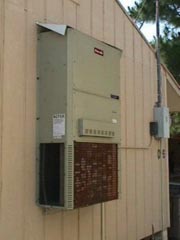
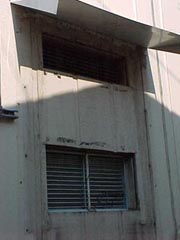
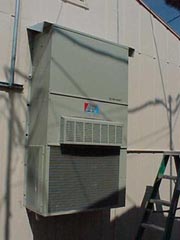
Figure 17. Left: old unit; Center: outer unit removed showing
thru-the-wall return grill and supply duct; Right: new HVAC unit.
At an outdoor temperature of 80oF, the existing Crispaire three ton unit drew just over 3,950 Watts, producing a 19.3 degree temperature drop across the cooling coil and a sensible cooling rate of 18,933 Btu/hr. Return and supply air flow were measured with a Shortridge flow hood, indicating 981 cfm - considerably lower than the 1200 cfm which should be indicated for a three ton machine. Measured latent heat removal was 7,048 Btu/hr for a total capacity of 25,980 with an EER of 7.6 Btu/W with a sensible heat ratio (SHR) of 0.73.
Under
similar outdoor conditions, the new 2½ ton Bard unit
with the ERV drew 3,730 Watts producing a drop across the evaporator
coil of 16.7 degrees with a coil air flow of 1,099 cfm. This
represented a sensible cooling capacity of 18,353 Btu/hr with
a latent heat removal measured at 7,909 Btu/hr for a total capacity
of 26,260 Btu/hr. The estimated SHR was 0.70 - showing the superior
latent heat removal of the new unit. The indicated EER was 8.7
Btu/W with the ERV in operation. Thus, the replacement unit showed
a similar cooling capacity to the larger original HVAC with a
6% drop in electrical demand even with greater outdoor air being
introduced.
For Portable 035 the typical savings were 45% on similar occupied
school days. However, as shown in Figure
18, much of the savings in Portable 035 are due to the automated
control of the HVAC unit.
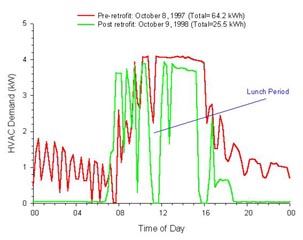
Figure 18. HVAC power use for Portable 035. The red trace
is pre-retrofit energy
use (64.2 kWh) and the green trace is post
retrofit energy use (25.5 kWh).
Occupancy Controls
The occupancy sensors function to turn the HVAC and lighting on when the portable is in use and consistently turned off during unoccupied periods. The setup uses two occupancy sensors (DT-100L and DT-200; Figure 19) manufactured by Wattstopper Inc. The controls use passive infrared and ultrasonic sensing to control the lights and HVAC operation. One control is located at the front of the classroom and another at the rear to ensure complete coverage of the space. Details of the system and configuration are contained in Appendix C.
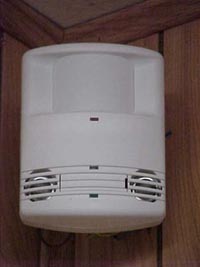
Figure 19. DT-200 occupancy sensor.
The majority of the energy savings come during the unoccupied periods when the HVAC is off after the retrofit, while during the pre-retrofit period the HVAC was cycling on and off 24 hours a day. However, this figure also points out that during peak time the new unit used about 5% less energy (~180 W) than the old unit. Also, much of the overall reduction is due to the roofing change and lower internal heat from the lighting although the individual impact is difficult to separate in this analysis.
Figure 20 depicts the air conditioner use on the two portable classrooms on a teacher work day where the classroom is only occupied for a few hours. Note the difference in energy use during unoccupied periods before 7 a.m. and after noon. The occupancy sensor control on the system in Portable 035 turns off the HVAC when the classroom is unoccupied while the unit on Portable 096 cycles on and off during these periods because there is no automated control. This illustrates the importance of automated controls in energy reductions because during these periods Portable 035 used 7% less energy than 096. During the occupied periods, the energy use of the portables is similar.
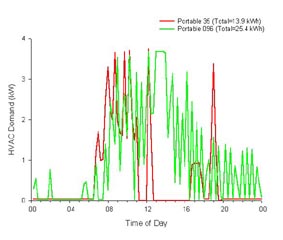
Figure 20. HVAC energy use comparison for both portables on
August 14, 1999
showing the lower use at Portable 035 with the automated
controls.
Ventilation
Interior carbon dioxide (CO2) levels in densely occupied classrooms are a good indicator of potential for pollutant concentrations as well as ventilation quality. Previous experience has shown both elevated CO2 levels >2,500 ppm in portable classrooms as well as indoor air quality complaints (IEQ Stratagies, 1997; Shirey et. al., 1997).
The superior CO2 control of the replacement HVAC was provided by the enthalpy recovery wheel which adds a large volume of outside air which was first cooled and dried by exhaust air prior to being introduced into the classroom (Figure 21). A comparison test of the air conditioning units was performed by measuring the rate of decay of a tracer gas (sulfur hexafluoride - SF6) by a sensitive Bruel and Kjar Model 1302 gas sampling unit (Figure 22). The pre-retrofit AC unit provided a ventilation rate of 0.68 air changes per hour (ACH) while the new unit with the ERV had a ventilation rate of 3.38 ACH, an increase in effective ventilation of almost 500%! This translates to approximately 2.6 cfm/student for the old unit and 13.0 for the replacement system which much more closely complies with the ASHRAE 62-1989 standard.
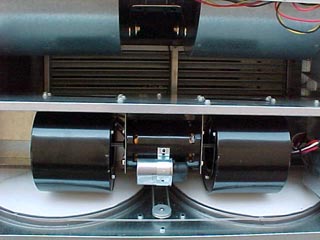
Figure 21. Enthalpy Recovery Ventilator (ERV) in the Bard 2
1/2 ton HVAC
units responsible for improvement of ventilation of
the two classrooms.
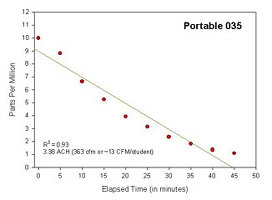

Figure 22. Measured indoor ventilation rate in two portable
classrooms after the ventilation
system is installed in Portable
035. The test use sulfur hexafluoride tracer gas decay.
Portable
096 shows only about 73 cfm being introduced as compared with 363
cfm with the ERV system.
The impact of the superior ventilation is demonstrated in Figure 23. The CO2 concentrations (in parts per million) in Portable 096 decrease by 43% after the introduction of the ERV.

Figure 23. Measured interior carbon dioxide concentration
in Portable
096
before and after greater outdoor ventilation air
was provided by ERV.
Despite this large increase in volume of ventilation air added to Portable 035, the interior relative humidity increased by only 7%. Figure 24 shows how the average interior humidity varied in the two portables over the two year monitoring period. Typically interior relative humidity would be raised by 10-15% by such an increase in outdoor air. However, the modest increase in humidity demon-strates the enhanced moisture control through the use of the enthalpy recovery system.
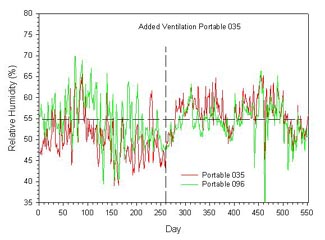
Figure 24. Impact of added ventilation on interior relative
humidity for Portable 035 compared with
Portable 096. A reference
line is provided at 55% as a reasonable target in Florida's humid
climate.
HVAC Installation Quality
Our study found that physical HVAC installation quality in portable classrooms may be poor. Figures 25 and 26 shows both a photo and a thermograph of the AC unit on Portable 035 before the HVAC retrofit showing the units loss of cool air as leaking supply air cools the exterior wall of the portable (blue to violet colors). As with the previous thermographs, color is proportional to temperature with the darker colors being cooler and the lighter colors hotter. After the retrofit, this supply leakage problem was solved and all the cool air was effectively delivered to the interior.
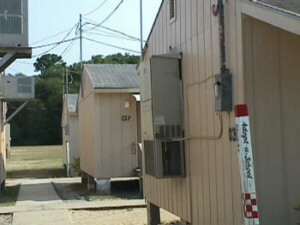 Figure 25. AC unit on Portable 035 before retrofit. |
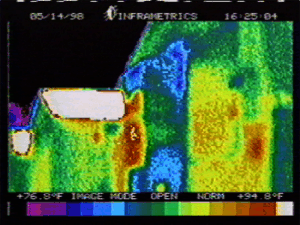 Figure 26. Leaking supply air cooling exterior walls. |
This problem underscores the need to perform quality control on HVAC installations on portable classroom space conditioning systems.
Roof Retrofit
The roofs originally had gray asphalt shingles that were torn off and replaced with 5V-crimp reflective white metal roofing (Figure 27). Roof replacement for Portable 035 was completed in June 1998 and for Portable 096 the end of September 1999.
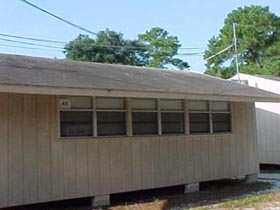
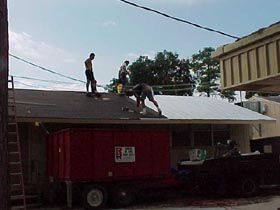
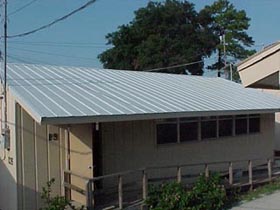
Figure 27. Roof replacement on the portable classrooms. Left:
old gray asphalt shingle roof;
Center: roof being removed; Right:
singles replaced by the white metal roofing.
As shown in the plots below (Figure 28), the peak plenum temperatures above the classroom associated with the gray asphalt shingle roof were quite high. This is due to high solar irradiance combined with high solar absorptance of the shingles. The roof surface temperatures reached over 150oF. Roof plenum temperatures can have a substantial impact on both ceiling heat transfer and student comfort. Note how peak plenum temperatures are reached just after noon.
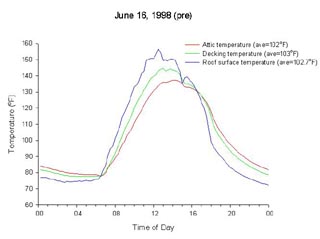
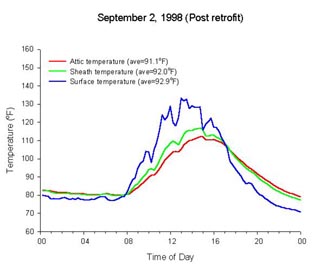
Figure 28. Comparative attic and roof system temperatures
pre and post retrofit
of reflective roof system October 97 - May
98 and October 98 - May 99.
The roof system temperatures evidenced a dramatic decrease after roof replacement. The reduction in peak plenum temperatures with the new roof system were over 25oF reducing the need for mechanical cooling and improving thermal comfort in the classroom below (also shown in Figures 13, 14 and 28).
The impact of the reflective roof was assessed by examining how the cooling energy load varied during the week before and after the roof system retrofit in Portable 096. The roof replacement was performed in late September, 1999. No other changes were made to the portable during this time and temperature conditions were consistent pre and post to allow a reasonable comparison.
Figure 29 shows how the air conditioning load profile varied in the two weeks. Loads from midnight until 7 a.m. are very similar. Savings begin at approximately 9 a.m., greatly increasing in the period after lunch when average reductions of over 1400 Watts are observed in cooling peak demand. Cool-ing demand is also reduced during the early evening hours due to the lower plenum temperatures above the classroom. Based on the analysis, overall cooling energy savings are over 33%.
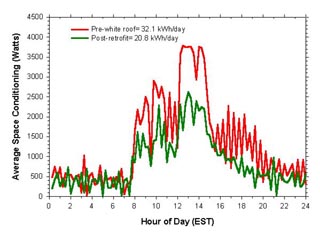
Figure 29. Average air conditioning loads in Portable 096
in the week
pre and post reflective roof retrofit at the end of September.
Results
Seasonal Variation In Savings
Comparison's for several months of the year were made for energy and lighting use for Portable 035 since post retrofit was available over an extended period. Figures 30 and 31 show the comparable results for each month for HVAC and lighting, respectively.
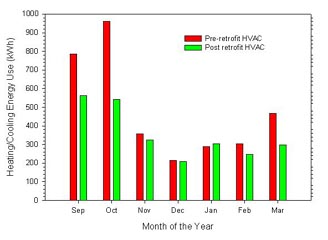
Figure 30. Monthly variation in space conditioning energy
savings. Savings are
greatest
in the warmer months when the reflective
roofing system provides the most benefits.
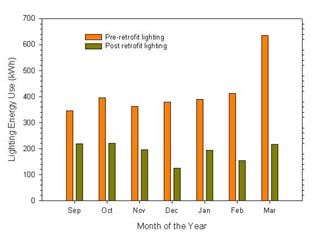
Figure 31. Monthly variation in lighting energy savings. Reduction
is greatest in March
due to many hours with lighting left on after
hours during this month.
Lighting energy savings for the month of October were 44% (174 kWh) while for the HVAC system it was much larger in absolute terms (44% or 405 kWh). The total energy savings for the month of October was 44% (594 kWh). Florida schools often have their highest utility bills in October.
The energy savings for the month of November from the lighting system was 46% (142 kWh) while the AC savings was 9% (38 kWh). Total energy savings for November after the retrofit was 28% (150 kWh). The lower savings reflects less cooling energy demand in this month and less impact of the reflective roofing system.
The total energy savings for the month of December were 32% (140 kWh). Lighting savings were significant at 55% (138 kWh) while HVAC savings were only 2% (1 kWh). The minimal savings of the HVAC was due primarily to the ability to use natural ventilation for the month of December and the ambient temperature for the month pre-retrofit was 6oF cooler so heating may have been used more for some days in the morning.
The total energy savings for the month of January was 27% (145 kWh). Lighting savings were again significant with a 50% (196 kWh) energy reduction. However, HVAC use actually increased by 5% (44 kWh) in the post retrofit January. This was likely due to a greater use of heat in the mornings to warm up the portables coupled with the higher level of outdoor air being introduced.
Total energy savings for the month of February were 44% (794 kWh). Lighting energy savings were the greatest with a 63% (659 kWh) reduction. The savings associated with the HVAC system were 18.2% (44 kWh).
An energy reduction of 53% (589 kWh) was achieved in March. Lighting savings were 66% (419 kWh) and HVAC savings were 36% (170 kWh). The large lighting energy reduction is attributed to poor control after regular school hours in the pre-retrofit period (neglecting to turn off lights consistently).
The
energy savings for the 2½ ton HVAC system varied more
than lighting by month due to the variation in cooling energy
demand and the changing impact of the reflective roofing system.
Economics
Below we summarize the monitoring results for each technology monitored within the project. We also describe the incremental expense of each measure based on installed costs collected within the project. Finally, we estimate the simple payback for each application, both for new portable classrooms and for existing ones.
The costs are much lower for most items if incorporated at the time of classroom manufacture. A good example is lighting. The base system consists of 24 two-tube fixtures with a magnetic ballast in each. The retrofit system consists of the same number of T8 tubes (48) which cost approximately $1 more per unit than the T12 lamps. However, the electronic ballasts in the retrofit system cost twice as much per ballast ($20 each), but are tandem wired so that only one ballast is used for every two fixtures. This reduces the cost in new applications to the incremental costs of the T8 lamps themselves. For retrofit, we assume that half a day will be required to make the necessary wiring and lamp changes - effort that is not expended when the system is configured in this fashion from the beginning. Thus for new portables the incremental cost for better lighting is only for the lamps themselves.
Table
2
Energy Savings of Each Efficiency Measure Projected
Over a Year for a Single Portable Classroom
| Efficiency
Measure Description |
Annual
Energy Savings kWh |
Cost New |
Simple Payback Yrs. |
Cost Exist |
Simple Payback Yrs. |
| T8 Lighting System | 1,679 | $50 | 0.4 | $400 | 3.0 |
| Occupancy
Control* Lighting HVAC System Both |
876 1,643 2,519 |
$300 $300 $300 |
4.3 2.3 1.5 |
$400 $400 $400 |
5.7 3.0 2.0 |
| AC/
Ventilation Package Hi-efficiency
Heat Pump w/ ERV ventilator White metal roof Total HVAC Package |
NA NA 910 |
$1,035 $ 700 $1,735 |
NA NA 24.0 |
$3,045 $3,100 $6,145 |
NA NA NA |
| TOTAL PACKAGE | 5,110 | $2,085 | 5.0 | $6,945 | NA |
All
costs are incremental costs over lowest cost competing system.
* All cost data for the occupancy control includes $100 for a
service call to fine tune time delay and
sensitivity for the application in a specific classroom.
Note, that the lighting and automated controls are extremely cost effective, both in new as well as existing applications. This indicates that substantial cost effective energy savings are potentially available in Florida's large stock of existing portable classrooms. These two measures alone show the potential to cut energy use by over 30% (11.5 kWh/day) with combined pay backs of less than three years.
The individual performance of the reflective roofing, more efficient heat pump and enthalpy recovery ventilation (ERV) system cannot be broken apart within the monitoring results. However, we know that the change in demand of the two air conditioning systems is only about 6% when operating and that the ERV, even though recovering both sensible and latent heat from the added outdoor air, is still adding moist, warm ventilation air which will increase cooling loads. Thus, most of the reduction in space cooling is coming from the white reflective roof and the lower level of sensible heat gains from the more efficient lighting. While the HVAC/roofing measures are not so cost effective as the lighting and controls retrofits, the combination is able to provide much greater ventilation levels and potentially improved indoor air quality while still reducing space conditioning energy costs.
Another advantage of the proposed reflective roofing system is the longevity of the metal roofing. Based on data from roofing contractors, metal roofs of the type used in the project retrofit have a 30 year life expectancy compared with only 15 years for fiberglass shingle roofs (Roofer, 1997). This makes for a lower cost roofing system over the long run, based on re-roofing costs. The energy savings then become a side benefit.
The
overall package of measures evaluated have an added costs of
about $2,100 when incorporated into new portable classroom manufacture.
This investment produces energy savings which pays for the added
cost within 5 years (equivalent to a 20% rate of return on investment).
More importantly, the proposed technologies improve the learning
environment. The effective indoor ventilation rate is increased
to comply with ASHRAE Standard 62-1989, while desk-top illuminance
levels and color rendering are improved by the more efficient
lighting.
Conclusions
Our project conclusively demonstrates that straightforward alterations in portable classroom equipment and roofing can produce very large reductions in total facility energy consumption. A typical Florida portable classroom uses about 30 kWh/day as verified by our monitoring. Energy end use is evenly split between lighting and space air conditioning which accounts for more than 95% of total consumption. The following retrofits were installed into two classrooms:
-
T8 lighting system with electronic ballasts
-A high efficiency heat pump with enthalpy recovery ventilation
-A metal white reflective roof system
-An occupancy based control system for lighting and air conditioning
These energy improvements have the large side benefit of potentially improving classroom indoor air quality and illuminance levels. The overall measured savings of the energy retrofits in the portable classrooms are summarized in three plots.
Figure 32 shows how the T8 lighting system and occupancy control reduced lighting energy use by an average of 53% (7 kWh/day) from one year to the next. The automated controls were found to be responsible for about 2.4 kWh (19%) of the savings. Total annual savings were estimated at 2,550 kWh, worth about $200 at current electricity prices. Lighting energy savings were fairly consistent year round.
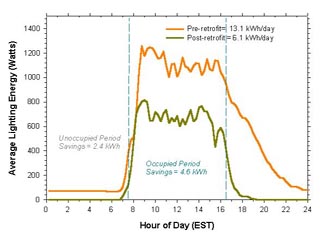
Figure 32. Time of day lighting energy demand in the
year before (orange) and after (green) retrofit.
Figure 33 shows how the improved heat pump, white roof and reduced internal heat from the more efficient lighting was able to cut daytime space conditioning elec-trical demand while providing five times the ventilation air (13 cfm/student) found in the base situation. This cut internal CO2 levels and with potentially beneficial impact on indoor air quality. Savings in space conditioning during the occupied period was 2.4 kWh/day or about a 14% reduction in daily energy use. The value of the occupancy controls was demonstrated in the large level of savings produced during unoccupied hours. This represented 4.5 kWh/day or a reduction in space conditioning of about 25%. Total reduction in space conditioning energy needs was 39% or about 6.9 kWh/day. Annually, the 2520 kWh savings is worth about $200 in reduced operating costs.
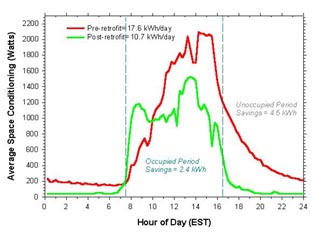
Figure 33. Average space conditioning energy demand
before (red) and after (green) retrofit. Savings come from
a package of measures.
Figure 34 shows the total impact of all the retrofits on overall energy consumption in Portable 035 from the baseline year to the 1998-1999 when all retrofits were in place. Measured annual energy reduction for the overall project averaged 12.6 kWh/day for a reduction of 41%. Although miscel-laneous consumption increased slightly in the year post retrofit, the total annual energy savings have a value of about $370 a year in reduced operating expenses.

Figure 34. Total average daily energy demand in the year before
(red)
and after (green) retrofit. Time of day energy savings are
shown in blue.
Our
results demonstrate that it is very feasible to alter new portable
classrooms in Florida so that they use 40% less electricity than
standard practice. The improvements were shown to be cost effective,
both for retrofit of existing portables classrooms as well as
for re-design of new facilities. Further, our findings show important
side benefits. Better ventilation and potential indoor air quality
result from the HVAC improvements. Also, the more efficient lighting
provides superior desk top illumination. Together, the measures
not only save on energy related operating cost, but can also
significantly enhance the learning environment.
Acknowledgements
We would like to thank the Florida Department of Education
for their participation with this project. We thank Silver Sands
Middle School for their continued enthusiasm throughout the project.
Finally, we thank Manufacturers' Marketing Representatives
Incorporated and Bard Manufacturing for providing
the 2 1/2 ton heat pump units used for this project.
References
Anderson, R. W., D. W Yarbrough, R. S. Graves, and R. L. Wendt, 1991. "Preliminary assessment of radiation control coatings for buildings. Insulation Materials: Testing and Applications, 2d vol., ASTM STP 1116, R. S. Graves and D. C. Wysocki, eds. Philadelphia: American Society for Testing and Materials.
Arundel, A., Sterling, E.M., Biggin, J.H. and Sterling, T.D., 1986. "Indirect Health Effects of Relative Humidity in Indoor Environments," Environmental Health Perspectives 65, p. 351-361.
Brown, G.Z., D. Bjornson, J. Briscoe,S. Fremouw, P. Kumar, P. Larocque, D. Northcutt,Z. Wang, D. Rasmussen, K. Rasmussen, J. Stanard, 1997. "Design and Evaluation of Energy-Efficient Modular Classroom Structures, Phase II." University fo Oregon, Eugene, OR and Modern Building Systems, Inc., Aumsville, OR.
Callahan, M. P., D. S. Parker, W. L. Dutton, and J. E. R. McIlvaine, 1997. "Energy Efficiency for Florida Educational Facilities: The 1996 Energy Survey of Florida Schools". FSEC-CR-951-97, Florida Solar Energy Center Cocoa, FL.
Downing, C. C. and C. W. Bayer, 1993. "Classroom Indoor Air Quality vs. Ventilation Rate," ASHRAE Transactions, Vol. 99, Pt. 2, American Society of Heating, Refrigerating and Air Conditioning Engineers, Atlanta, GA.
Educational Facilities Laboratories, 1964. Educational School Facilities. New York: Author (ERIC Document Reproduction Service No. ED 066 846).
Florida Department of Education, 1999. State Requirements for Educational Facilities, Chapter 7, Office of Educational Facilities, Tallahassee, FL.
Florida Today, "Portable classrooms may be here to stay," Mary Shedden, March 3, 1997, p.1.
Floyd, D., D. Parker, J. Sherwin, and J. E. R. McIlvaine, 1995. "Energy Efficiency Technology Demonstration Project for Florida Educational Facilities: Occupancy Sensor". FSEC-CR-867-95, Florida Solar Energy Center Cocoa, Florida.
The Florida Center of Community Design and Research, 1993. "The use of relocatable classrooms in the public school districts of Florida.". (A research report for the Florida Department of Education, Office of Educational Facilities). Tampa: University of South Florida, Nov. 16, 1993.
Givoni, B., 1976. Man, Climate and Architecture. London : Applied Science Publishers Ltd.
Hathaway, W.E., Hargreaves, J.A., Thompson, G.W. and Novitsky, D., 1992. "A Study into the Effects of Light on Children of Elementary School Age," Edmunton Department of Education, Alberta.
IES, 1998. "Educational Facilities Lighting," RP-3-88, Illuminating Engineering Society, NY.
IEQ Strategies, 1997. "Investigators Look to Improve Ventilation in Portable Classrooms," Cutter Information Corporation.
"Metal Roofing," Tony Chiovare, Roofer Magazine, Business News Publishing, July, 1997, p. 48-49.
McKinley, J., 1991. "New Standards for Classroom Lighting," American School and University, May, 1991.
McIlvaine, J. E. R., M. Mallette, D. Parker, P. Lapujade, D. Floyd, L. Schrum, and T. Stedman, 1994. "Energy Efficiency Design for Florida Educational Facilities". Prepared for the Florida Department of Education, Florida Solar Energy Center Cocoa, Florida.
Parker, D. S., L. Schrum, J. K. Sonne, and T. C. Stedman, 1996. "Side-by-Side Testing of Commercial Office Lighting Systems: Two-Lamp Fluorescent Fixtures". FSEC-PF-301-96, Florida Solar Energy Center Cocoa, Florida.
Rasmussen, E., K. Rasumussen, J. Stanard, S. Bernhard, G. Z. Brown, J. Briscoe, J. Kline, P. Kumar, and Z. Wang, 1995. "Design and Evaluation of Energy Efficient Modular Classroom Structures". Modern Building Systems, Inc. Aumsville, Oregon and University of Oregon, Eugene, Oregon.
Sherwin, J. R. and D. S. Parker, 1996. "FLASTAR: Florida Alliance for Saving Taxes and Energy Resources". FSEC-CR-916-96, Florida Solar Energy Center Cocoa, Florida.
Shirey, III, D.B., R.A. Raustad, and M. Brassard, 1997. Evaluation of an Enthalpy Recovery Ventilator Installed in a Portable Classroom, FSEC-CR-972-97, Florida Solar Energy Center, Cocoa, FL.
Stoddard, B.C., 1997, "Public Schools Not Making the Grade," The Construction Specifier, September, p. 29-36.
1 A move
within Florida is in progress to limit the further expansion
of portable classroom utilization through requirement of covered
walkways to the facilities.
*Submitted
to:
Suzanne Marshall
Florida Department of Education
Office of Educational Facilities
325 W. Gaines St., Rm. 1054
Tallahassee, FL 32399
